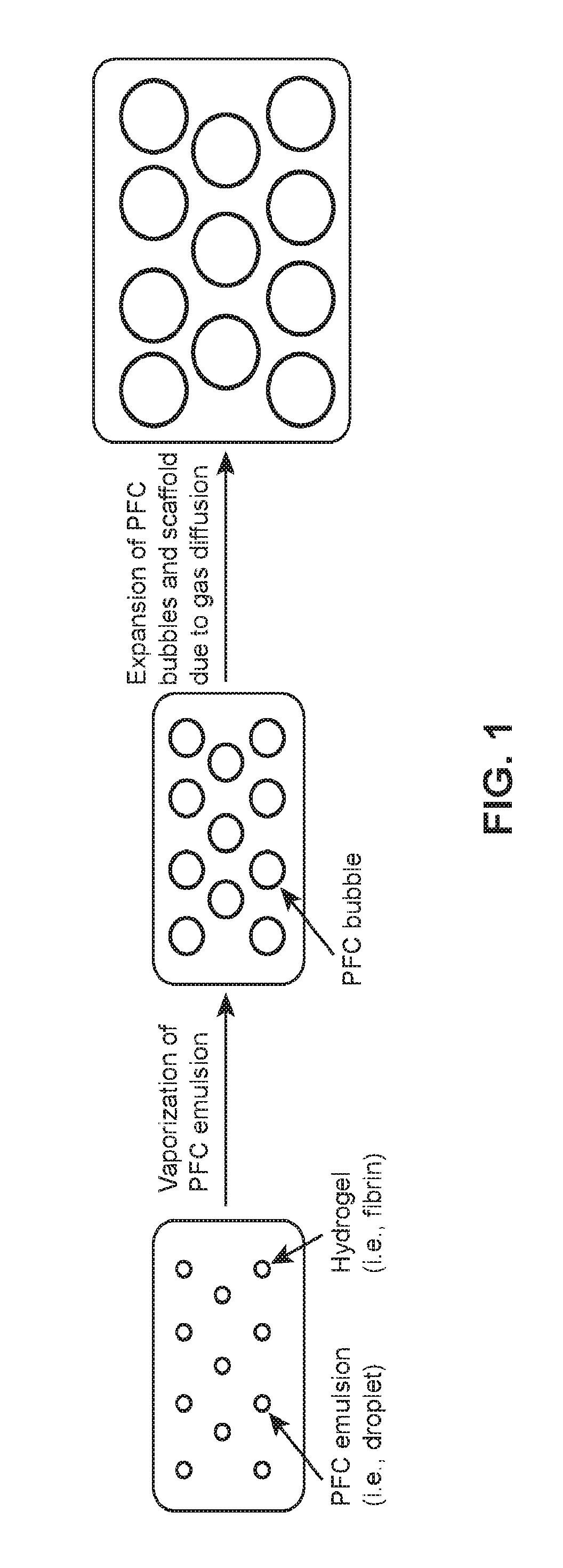Biodegradable hydrogel for tissue expansion
a biodegradable hydrogel and tissue technology, applied in the field of biodegradable hydrogel for tissue expansion, can solve the problems that biochemical (e.g., gfs) or mechanical (e.g., microporosity) cues presented in a conventional fibrin scaffold cannot be externally controlled spatially or temporally, and the development of responsive scaffolds is limited
- Summary
- Abstract
- Description
- Claims
- Application Information
AI Technical Summary
Benefits of technology
Problems solved by technology
Method used
Image
Examples
example 1
[0226]In this example, a mixture containing all of the components required for the hydrogel scaffold, including the perfluorocarbon (PFC) emulsion, is injected at the site of intended tissue / skin expansion. The mixture polymerizes within minutes, thus forming a solid structure at the implantation site. Body heat and scaffold degradation will cause the PFC emulsion to convert from liquid droplets into gas bubbles. The gas bubbles, which remained trapped within the scaffold, will begin to expand due to the diffusion of dissolved gas (e.g., oxygen) within the scaffold and gas present in the extravascular space. Thus, bubble growth leads to expansion of the hydrogel, which causes the overlying tissue / skin to expand (FIG. 1). The PFC emulsion can also be phase transitioned from liquid droplets into gas bubbles using focused ultrasound. This would enable anisotropic expansion of the scaffold by spatially patterning bubble formation within the scaffold as well as scaffold degradation.
[0227...
example 2
[0230]Hydrogel scaffolds are used in tissue engineering as a delivery vehicle for regenerative growth factors (GFs). Spatiotemporal patterns of GF signaling are critical for tissue regeneration, yet most scaffolds afford limited control of GF release, especially after implantation. Acoustic droplet vaporization (ADV) can control GF release from a fibrin scaffold doped with a perfluorocarbon emulsion (see, e.g., U.S. Patent Application Publication No. 2013 / 0330389, incorporated by reference herein in its entirety). This study investigates properties of the acoustically responsive scaffold (ARS) critical for further translation. At 2.5 MHz, ADV and inertial cavitation thresholds ranged from 1.5-3.0 MPa and 2.0-7.0 MPa peak rarefactional pressure, respectively, for ARSs of varying compositions. Viability of C3H10T1 / 2 cells, encapsulated in the ARS, did not decrease significantly for pressures below 4 MPa. ARSs with perfluorohexane emulsions displayed higher stability versus perfluorope...
example 3
[0264]The goals of this study were to 1) evaluate the biocompatibility of the ARS when implanted subcutaneously; 2) determine the extent to which the fibrin component of the ARS degrades when implanted subcutaneously; and 3) assess morphological changes of the ARS. Blood vessel formation in the ARSs was also characterized since effective tissue expansion is dependent on generating new vasculature to provide oxygen and nutrients to the growing skin.
Materials and Methods
Double Emulsion Preparation and Characterization
[0265]Double emulsions with a water-in-perfluorocarbon-in-water (W1 / PFC / W2) structure were prepared by modifying a previous method [1]. Briefly, a triblock fluorosurfactant, consisting of Krytox 157FSH (CAS #51798-33-5, DuPont, Wilmington, Del., USA) and polyethylene glycol (MW: 1000, CAS #: 24991-53-5, Alfa Aeser, Ward Hill, Mass. USA), was dissolved in lg of perfluorocarbon (PFC) at 2% (w / w). The PFC phase consisted of perfluoropentane (subsequently referred to as “C5”,...
PUM
| Property | Measurement | Unit |
|---|---|---|
| Fraction | aaaaa | aaaaa |
| Fraction | aaaaa | aaaaa |
| Fraction | aaaaa | aaaaa |
Abstract
Description
Claims
Application Information
 Login to View More
Login to View More - R&D
- Intellectual Property
- Life Sciences
- Materials
- Tech Scout
- Unparalleled Data Quality
- Higher Quality Content
- 60% Fewer Hallucinations
Browse by: Latest US Patents, China's latest patents, Technical Efficacy Thesaurus, Application Domain, Technology Topic, Popular Technical Reports.
© 2025 PatSnap. All rights reserved.Legal|Privacy policy|Modern Slavery Act Transparency Statement|Sitemap|About US| Contact US: help@patsnap.com



